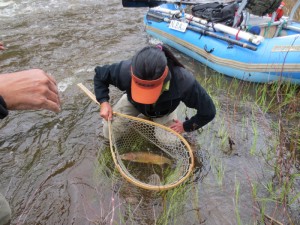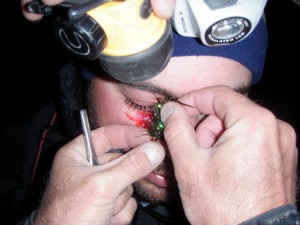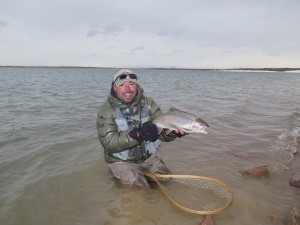Rubber Nets and Barbless Hooks
I caught a trout! What do I do now?
You’ve got a trout in the bag, so how do you handle it to ensure a safe release?
Effective catch and release starts before you’ve ever made a cast and a great start would be to invest in a net with a rubber bag. Not only does a rubber net bag protect the fish but it also is resistant to hooks. A hook buried in a cloth net is almost useless by the time you get it out.
Barbless hooks are by far the best way to go. We fish barbless hooks every day at NPA and we find them to be just as effective at holding fish as a barbed version, given the line is kept tight. Barbless flies generally last longer than barbed flies because you rarely need to use forceps to remove them. In addition to being easier to remove from fish, they’re a lot easier to remove from yourself or your buddy if someone happens to get hooked. No one wants to leave a hot bite to have a hook removed at the hospital. Unfortunately, we’re not able to give fish medical attention. If a fish is hooked deep, its best to clip the line as close as possible and allow the hook to rust out or work its way out slowly, rather than pulling or prying, doing more damage.
So the fish you just bagged is big, possibly the biggest fish you’ve ever landed. We need a photo of this one. First things first, we’ll remove the hooks so they’re out of the way. We need to handle this fish gently so we, or another angler, might get another shot sometime down the road. Fish are nearly weightless under water and need to be fully supported when lifting them up for a photo to make sure we don’t do any unnecessary damage. The best way to lift a fish out of the net is to get a firm grip on the tail with your dominate hand, and then cradle the fish between the pectoral and dorsal fins with your other hand. It is very important that we’re cradling the fish and not squeezing its vital organs. Fish don’t have a rigid rib cage like we do, so we need to be very careful. Another thing to remember: Fish can’t breathe when we’re holding them out of the water. If you need extra time to get a photo, make sure the fish is fully submerged in between shots so they can catch their breath.
If you’d like to have your fish replicated as a mount, there are a few things you need to do for the artist: You’ll want to measure overall length as well as girth. Take your girth measurement from in between the pectoral and dorsal fins. Take close-up photos of the head, side, and tail so the artist can replicate the markings and color of the fish. We prefer fiberglass reproductions over actual skin mounts. Fiberglass mounts are more durable and longer lasting than skin mounts. Fiberglass replicas are also much easier to repair if they ever get damaged.
The photos and measurements have been taken and now it’s time for big mama to go back home. We need to revive the fish by using the same cradling hold as we did while taking photos and getting some oxygen flowing over her gills. In a stream, all you need to do is hold the fish upstream, facing the current, until she has enough energy to swim away on her own. In a lake, we need to gently move the fish forward (not back and forth) so water enters the gills through the mouth helping oxygen enter the gills.
Hopefully this post helps ease the practice of successful catch and release. It’s always good to have a plan when you do get that monster in the bag. If you follow these steps, you can have confidence that your trophy will live to see another day!







